Best Disability Insurance Options For Teachers | Even If You Have Some Through Work, You May Not Be Fully Covered
Updated: April 12, 2024 at 9:38 am
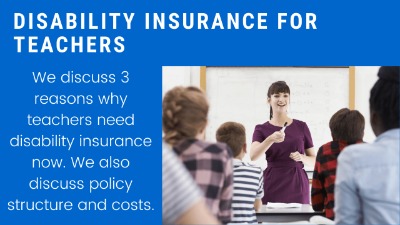 In this article, I discuss the best disability insurance options for teachers.
In this article, I discuss the best disability insurance options for teachers.
I also go into detail about what constitutes a great policy, discuss underwriting, and discuss costs.
This is a complete guide for teachers and educating them on disability insurance.
If you are a teacher, you may not think you need disability insurance. You may already have some through your employer. But, as we will discuss, that may not be enough.
Your job is more important than people realize. Each day brings something different. The impact you make on your students can be felt for years.
However, what if you could no longer do your job?
Have you ever thought about what would happen if you became sick, ill, injured, and disabled?
How would you pay your bills if you could not work and teach?
What would happen to your family?
Disability quickly affects your plans and lifestyle. In this article, we discuss disability insurance and the best disability insurance options for teachers.
Here’s what we will talk about:
- What Is Disability Insurance?
- 3 Great Reasons Why Teachers Need Disability Insurance
- The Characteristics Of A Strong Disability Insurance Policy For Teachers
- How Carriers Underwrite Your Application
- Best Disability Insurance Options For Teachers
- Estimated Disability Insurance Premiums
- Disability Insurance Through Your Union Or School
- Final Thoughts About Disability Insurance For Teachers
Let’s jump right into discussing what is disability insurance.
What Is Disability Insurance For Teachers?
Disability insurance is, simply, a type of insurance that pays you a monthly income if you can’t work due to illness or injury.
You can focus on getting better and back to work while the disability insurance policy pays you a benefit. You use this benefit to pay your bills like your mortgage, internet, etc.
Do teachers need disability insurance?
Many teachers tell me, “no”, but if you:
Make money, and
You use that money to pay your mortgage, groceries, and other needs, and
If you and your family would be in a tough financial situation if you could not work, then:

It is really that simple.
It’s Paycheck Protection
Think of disability insurance as “paycheck protection”. We have our house, cars, vacations, luxury items, and necessities.
vacations, luxury items, and necessities.
Think of all that. All of that is derived from your ability to work and earn an income.
Conversely, all of that is potentially gone if you can no longer work and earn an income.
Disability insurance replaces a portion of your income. How much monthly benefit amount do you receive if you can’t work? That depends on how much you make and your income. Depending on your situation as a teacher, carriers might insure up to 60% of your gross salary.
Wait, John. Why don’t I get 100% of my income, you ask?
Good question. Carriers rarely insure 100% of your income or salary. Why? Well, there are a couple of reasons:
- If you receive a benefit, your benefit is income tax-free. So, you pay no taxes on your benefit, and
- To incentivize you back to teach
Human nature tells us that if we receive 100% of our income, we probably don’t want to go back to work, right?
There are ways to potentially obtain 100% of your income. It is outside the scope of the article. If you want to learn more, feel free to reach out to us.
As a final thought here in this section, think of disability insurance as a “spare tire”. You don’t think of your spare tire (or AAA) until you need it. And, when you do, you are thankful you have that spare tire or the AAA membership. A temporary tire replaces your flat. You are back on the road, and you get your other tire repaired.
Disability insurance is no different, except it gets you back on the road of your life.
3 Great Reasons Why Teachers Need Disability Insurance
Now that we know what disability insurance is, let’s talk about the 3 reasons why teachers need disability insurance.
Wait, John, you say. I am not going to get disabled.
Is that right? How do you know? If you did know, you probably wouldn’t be a teacher.
Know what I mean? You don’t know. No one does.
This unknown brings us to our first reason.
Reason #1: A Disability Happens Anytime And To Anyone
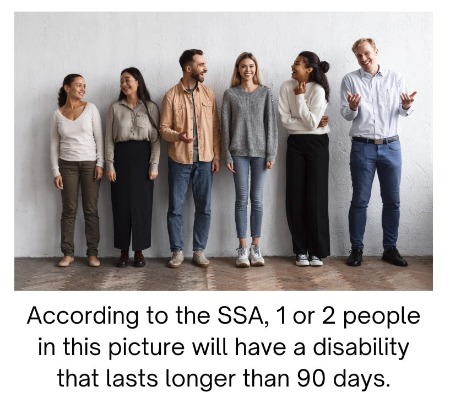 The chance of disability for all of us is really high. According to the Social Security Administration, an adult worker has a 1 in 4 chance of experiencing a long-term disability.
The chance of disability for all of us is really high. According to the Social Security Administration, an adult worker has a 1 in 4 chance of experiencing a long-term disability.
That is higher than common scenarios such as passing away from cancer (1 in 7) and even death from a car accident (1 in 107).
Remember, a disability is any injury or illness that prevents you from doing your job. So, a disability, depending on the type of teacher you are, could be a:
- Broken hand
- Cancer diagnosis
- Back injury
- Head injury
- Multiple sclerosis diagnosis
- Torn ACL
- Loss of eyesight
- Substance abuse
- Mental health conditions like bipolar disorder and other mental disorders
- A stroke
The list goes on and on…
No one plans for a disability. Disabilities do not discriminate. They do not care about your ethnicity, your job, or how much you make. A disability occurs when you least expect it.
Tiger Woods knows this. Recall his horrible car accident. He left his hotel at 7AM. Around 7:10, he became disabled. His job is golfing, and he can’t do that.
The difference between Tiger Woods and us is he has millions to live off of. We don’t.
What if you faced a situation where you could no longer work? That is a disability.
What if you can’t pay your bills because you can’t work?
However, a disability isn’t only a severe accident. It can be a cancer diagnosis, an ALS diagnosis, weird nerve pain shooting through arms that prevents you from using your hands.
Any type of illness or injury that prevents you from doing your job as a teacher is a disability.
What would you do if you could not bring in an income to support your family?
Now, do you see the importance of disability insurance?
Reason #2: A Disability Could Last A Long Time
Disabilities could last a while. I am aware of the statistics floating around the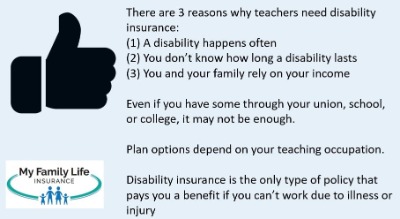 internet.
internet.
There is one that suggests that the average disability lasts almost 35 months. Possibly. The claims departments I speak to suggest, on average 18 months to 24 months. Nevertheless, could you and your family survive financially from 1.5 years to 3 years – or more – if you can’t work?
Some disabilities are longer. Disabilities from mental illnesses, mental impairment like dementia, or alcohol/drug abuse can last years. How do you know these unfortunate situations won’t happen to you?
Conversely, some are shorter. We just had a client who came off a disability claim from Leukemia. He was out of work for almost 11 months.
The moral of this section is you don’t know. Disability insurance protects you from this unknown. It pays you monthly disability benefits, which in turn you can focus on your rehab, treatment, and family. This brings us to our next section.
Reason #3: More Important People Rely On You
Here’s another important reason. You may think your students are the most important people. Who can be more important than them, you think? They are the reason I am a teacher.

True. They do matter. Let’s be honest, though, your students – or even the administration or school board – don’t love you as your family loves you. By far, if you have a family, your spouse and children rely on you more than you think. They love you more than anything.
If you are disabled, without disability insurance, you have to answer tough questions and make tough decisions.
- Would you and your family be able to continue your standard of living without your income? If not, what changes would need to be made?
- Would your spouse have to work or work more?
- Would you need to sell your home to make ends meet?
- Who could be flexible with the children?
- Would you have the money to hire someone to take care of the kids? The tough questions can go on and on.
I call disability the destroyer of dreams. Your future and family dreams could be destroyed. I’m being honest here.
They don’t have to, though. With disability insurance, you have peace of mind knowing that you have a plan – and income – in place should the unexpected happen.
Remember the spare tire/AAA analogy. That is the sole purpose of disability insurance: to provide payments to you in case you can’t work. Then, you can focus on rehab / getting better and getting back to work.
The Elements Of A Strong Disability Insurance Policy For Teachers
Hopefully, we have made a great case showing why teachers need disability insurance.
I’m ready to enroll now, John, you say.
Sounds great. First, though, let’s discuss the characteristics that make a strong policy.
You see, there are many policies that offer limited benefits.
You don’t want to mess with those policies. The worst thing that could happen is you file a claim, expect a payout, and don’t receive one.
So, let’s first discuss the basic elements needed in any disability insurance policy for teachers.
Disability Insurance Policy Basics – Elimination Period & Benefit Period
I speak to professionals, including teachers, about disability insurance every day. There are 2 major sources of confusion that these professionals hear from elsewhere. These confusing components are simply policy basics, but if you get these wrong, you could be in for a surprise when it comes time to make a claim.
The first is the waiting period or elimination period. In terms of disability insurance, it is not the period of time before your policy is in effect. That is correct for other types of insurance, but not for disability insurance.
The elimination period is the length of time – a waiting period – that elapses before you are eligible for disability benefits. It happens upon the disability claim and is retroactive to your disability date. For example, a 90-day elimination period means your benefit period will begin after 90 days of disability. On the 91st day, you are eligible for benefits. Typically, you receive your first benefit 30 days after that.
So, if you have a 90-day elimination period, you will receive your first payment on or around day 120 of disability.
This means you need to have adequate savings to carry you and your family until benefits begin.
Benefit Period
The second is the benefit period. The benefit period starts when you are eligible for benefits and lasts until the end of the benefit period or if you return back to work, whichever occurs first. It is not the maximum timeframe that your policy exists. As long as you pay the premiums, you will have the policy until age 65 or 66 – at retirement age.
The maximum benefit period for teachers is to age 67. This means you will have disability benefits for your working career, if you choose. However, a 5 year benefit period might work just fine, too, and save you money in the process.
The Disability Definition Matters
The definition of disability matters. You generally want some type of “own occupation” coverage.
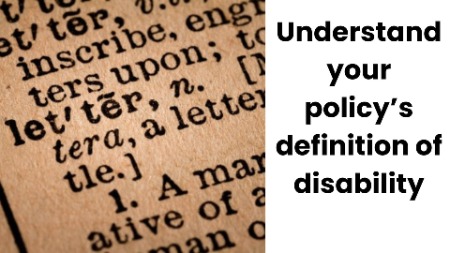 What is “own occupation” coverage? It means the carrier bases your claim approval (and subsequent payments) on your inability to do your job. In this case, teach.
What is “own occupation” coverage? It means the carrier bases your claim approval (and subsequent payments) on your inability to do your job. In this case, teach.
There are several types of own-occupation definitions. The most common are “true” and “modified”. What is “true own occupation”? Simply, it means you can continue to work in another occupation while receiving disability benefits for the inability to do your job as a teacher.
So, if you can’t use your hands, but you can greet people at Walmart, you will receive disability benefits in addition to your earnings as a Walmart greeter.
Modified own occupation is a bit different. You will receive a disability benefit based on your inability to teach. However, you can’t work in another job. So, if you work as a Walmart greeter, you won’t receive disability benefits under the modified own occupation definition. This is a good definition, too.
Be Aware Of The “Any” Occupation Definition
Finally, there is the stringent “any occupation” definition. This means, simply, if you can work in any gainful occupation (for which you are reasonably suited, considering your education, training, and experience), the carrier denies benefits. So, under this definition, you won’t receive a disability benefit based on your education and experience as a teacher because the insurance carrier says you can work as a Walmart greeter.
The plans we work with contain the favorable true own occupation definition for teachers. Moreover, you can align this definition to match some or all of your benefit period.
Do you need “true” own-occupation definition? Maybe not. It might depend on the type of teaching you do. If you are an elementary school math teacher, maybe not. However, if you are a piano teacher or industrial arts teacher, an own-occupation definition might be prudent.
Important Disability Insurance Elements For Teachers
When I review quotes, I usually see 2 elements missing from most quotes or policies. It is imperative your policy contains the following.
Residual or Enhanced Partial Disability Benefit
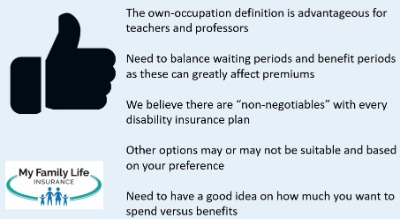
The disabilities we have implied so far in this article are total disabilities. In other words, you can’t work at all.
However, many disabilities start or end as a partial disability. What happens if you can work, but not full-time?
This is where you want partial disability benefits. Disability plans that offer partial disability benefits pays a pro-rated benefit for the time or work lost because of the partial disability.
Usually, the amount of disability income you receive is a percentage of your total monthly disability benefit. For example, let’s say you work 3 days a week now and therefore experience a 40% income loss. If your monthly disability benefit is $4,000, you will receive $1,600 ($4,000 X 40%). This is a simple example to illustrate.
However, beware. Many policies state they have partial disability benefits. But, when you read their definition, it states that partial benefits are paid after a period of total disability.
In other words, the carrier won’t pay a partial benefit if you haven’t met the carrier’s requirements of a total disability first.
That could be years before you become totally disabled. Take multiple sclerosis or carpal tunnel syndrome. Both of these conditions may start as a partial disability. However, if you don’t have adequate partial disability benefits, you won’t receive anything until you are totally disabled.
This scenario underscores the importance of partial disability benefits.
Proper partial disability benefits circumvent the total disability requirement. They allow you to receive partial benefits immediately (after you satisfy the elimination period).
Guaranteed Insurability Option
Let’s say you purchased a disability insurance policy 5 years ago. Your salary is now $25,000 more than what it was when you applied. You are now underinsured if you make a claim.
What do you do?
If you have a guaranteed insurability option, you can purchase more disability insurance with no evidence of health insurability. In other words, you don’t need to go through underwriting again.
That means if you now have type 2 diabetes or Multiple Sclerosis (for example), you can still purchase more disability insurance. How great is that?
You just need to prove your income increased, usually through a tax return or your W-2 stub.
 I’ve seen many policies that exclude this option. If you don’t include this option at the time of application, you will then need to reapply for a new policy if you want more disability insurance. If your health changed in any way, you could face benefit limitations, higher premiums, or declined altogether.
I’ve seen many policies that exclude this option. If you don’t include this option at the time of application, you will then need to reapply for a new policy if you want more disability insurance. If your health changed in any way, you could face benefit limitations, higher premiums, or declined altogether.
Optional Disability Insurance Riders For Teachers
You can add optional disability insurance riders at an extra cost to your policy to best fit your needs and budget.
Disability insurance is very customizable. If you want more benefits, however, expect to pay higher premium rates. Some popular rider options for teachers include:
Return of Premium Rider: You will receive the premiums you paid back if you never make a claim.
Retroactive Injury Benefit Rider: Pays additional benefits from the date of disability due to injury if disability occurs within 30 days of the injury and continues through the elimination period. Generally speaking, you receive a lump sum benefit on the first day of the month after you satisfy the elimination period.
Activities of Daily Living Rider: This rider pays an additional benefit if you can’t perform two or more of the activities of daily living. Additionally, it will pay if you are cognitively impaired. This condition is a catastrophic disability. In other words, this rider will pay an additional benefit if you need help or assistance with the first 20 minutes of your day – dressing, toileting, eating, transferring (i.e. walking), etc.
Accident Plan: pays an indemnity benefit (i.e. fixed dollar benefit) if you are hurt or injured and go to urgent care or ER. Some plans also pay a benefit for an accidental death.
Student Loan Rider: Pays a separate benefit for payment of your student loans
Social Insurance Rider: Coordinates your monthly benefits with social security disability benefits and other government benefits. Although you’ll enjoy a lower premium, I generally do not recommend this rider.
Mental/Nervous/Drug/Alcohol Extension: Most carriers provide a 2 year benefit period only for disabilities caused by mental or emotional disorders (like depression) or by drug/alcohol abuse. This option extends the 2 year benefit period to your contracted benefit period.
How Disability Insurance Carriers Underwrite Your Application
It’s important to understand how disability insurance carriers underwrite your application.
Oh, I just went through the life insurance process. I know how it works, you say.
Great. But, disability insurance underwriting is completely different.
Carriers aren’t insuring your mortality. They are insuring your morbidity. In other words, the risk of a disabling accident or illness and paying you a percentage of salary.
So, carriers look at the following attributes in an application.
When it comes to underwriting, carriers look at your:
- Age
- Health and answers to health questions on the application
- Income / Salary
- Occupation
- Other hazards and lifestyle situations
Age is a factor. The older you are, the more expensive the policy – all things being equal, of course. This is why you want to start your policy as soon as possible.
Obviously, your health matters. Carriers generally exclude pre-existing conditions of any previous chronic illness or severe injuries. Additionally, carriers can limit benefits based on any health conditions.
As we mentioned before, carriers insure a percentage of your salary or income. This percentage is usually 60% of your gross salary. In disability insurance terms, this amount is known as your replacement income
Your Teaching Occupation Matters
Your teaching occupation matters as well. All the disability insurance carriers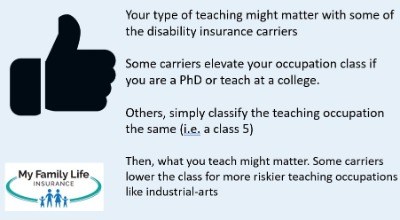 classify your occupational disability risk.
classify your occupational disability risk.
The classification table is usually a 1 to a 5 (or 6 with some carriers). An occupation with a class 1 is the most risky while an occupation with a class 5 is the least. For example, many carriers classify a construction laborer at a 1 and an accountant at a 5.
The classification for teachers, well, depends.
It depends on…
…which carrier that you use (some carriers categorize all teachers as a 5)
…your education level (some upgrade your classification if you have a graduate degree)
…where you teach (if you are a college professor, you may receive a classification upgrade)
…what you teach (a math teacher will have a higher classification than an industrial arts teacher)
Finally, carriers also consider other situations and lifestyle choices like hazardous hobbies. Do you like to rock climb? If so, that hobby will be excluded from your policy. (Related: see our article on how disability insurance underwriting works.)
What Do The Carriers Do With The Information?
The underwriters review all this information and make an approval decision or not. They routinely look up your medical background in the MIB, prescription drug databases, driving records, tax records, etc.
As we discussed, certain situations may limit benefits, your benefit period, and/or waiting periods. Carriers may also increase premiums to compensate for an increased disability risk.
Nevertheless, if the carrier modifies your plan in any way, it still makes sense to purchase the policy. We discuss more in our disability insurance underwriting guide.
Best Disability Insurance Options For Teachers
Who are the best disability insurance plans for teachers. While other websites list the carriers along with estimated price, we don’t. The reason is that many of these carriers have marketing rules to not mention their names or information. The reason is obvious: doing so could create confusion and the wrong expectations.
However, we work with all those same carriers and many more. Being an independent brokerage gives us the ability to find the right disability insurance for you and your specific information.
Additionally, all the disability insurance companies we offer for teachers include:
- true own occupation definition for part or all of the benefit period
- enhanced partial / residual benefits
- guaranteed insurability options
- other riders such as a student loan rider (if that is what you want), catastrophic coverage, etc.
The disability insurance coverage we have discussed so far is long-term disability insurance.
Long-term disability insurance covers you in case of a disability that lasts a few months or longer (happens alot, see above). We also offer short-term disability insurance for teachers. You probably receive short-term disability insurance through your school district, company, college, or union. Usually, short-term plans through these entities are sufficient as the benefit period is a few months. Additionally, these entities usually pay for some or all of the coverage.
Remember, the vital reason for long-term disability insurance is long-term income protection in case a disability (which happens often – see above) lasts longer than 3 months. What would you do for money if your disability lasts 1 year, 2 years, or longer?
Thankfully, we offer many affordable disability insurance options for teachers.
How Much Does Disability Insurance Cost For Teachers?
That’s the $64,000 question. Well, the premiums you pay are a function of everything we discussed above.
everything we discussed above.
However, disability insurance coverage is not incredibly expensive.
Depending on your situation, disability insurance costs between $1.00 and $3.00 per day. Sometimes it is more; sometimes it is less.
The cost is about the cost of a cup of coffee at your favorite coffee shop.
If you can afford a cup of coffee, or lunch, you can certainly afford disability insurance.
For example, a woman aged 40, making $50,000 annually could have a $2,500 monthly benefit, own-occupation definition policy for around $72 per month or $2.40 per day.
Again, the cost could be more or less depending on various factors, especially if you have disability insurance elsewhere.
Speaking of disability insurance elsewhere, many teachers get some disability insurance from their union, school, or association. Is it worth the cost?
What If My School, Association, Or Union Offers Disability Insurance?
This is a common scenario for teachers. Many unions, private schools, associations, and colleges offer disability insurance to their teachers and professors.
Some programs call your disability insurance a disability allowance. It’s the same thing.
John, my school offers disability insurance. I’m all set.
Yep. I hear this all the time from teachers. They think because they receive disability insurance from their school, union, or association they are all set.
However, you aren’t all set. You likely aren’t covered much at all. We explain more.
It’s Group Disability Insurance
Disability insurance through your school, union, college, or association is group insurance. Group insurance is different than individual, private insurance.
For instance, many group disability insurance policies limit benefits in one way or another.
For example, we reviewed the group policy of a woman who makes $100,000 annually. She was astonished to find out her group disability insurance policy provided a maximum $2,000 monthly benefit. That amount is well below full coverage for her.
So, the first thing is that many group plans cap the monthly benefit to like $2,000 or $3,000.
Can you live off of $2,000 per month?
No way!
Potentially Taxable Monthly Benefit
Additionally, that benefit from your group policy is taxable. That means you have to pay income taxes on it. Your employer will note this responsibility on form 1099G in January. Note that disability benefits from an individual policy are not taxable.
So, if your employer’s plan pays 60% of your salary as a benefit, that might mean you are netting 40% (or around there) post-tax.
Can you live off of 40% of your salary? Likely not. Most people probably can’t.
That is where an individual plan helps. You can “stack” an individual plan on top of your group disability plan. Your individual plan will offset any tax impact and bring your overall disability benefits in line with your income.
Is it expensive? Usually, never.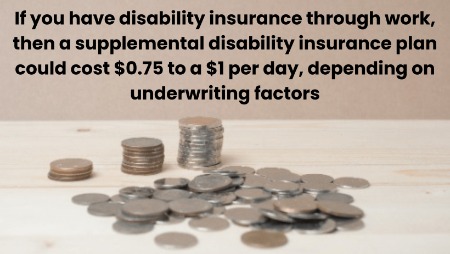
To illustrate, Let’s use the same example previously with the 40-year-old woman, making $50,000 annually. Her school offers a group disability insurance plan, in which they pay 100% of the premiums. She receives a $2,500 benefit from her group plan.
If she files a disability claim, that $2,500 is taxable. Based on her situation, she can purchase a supplemental plan. She could purchase up to a $1,000 monthly benefit for about $25 per month. That is only $0.75 per day.
The $1,000 will offset any taxes. Additionally, it provides a more complete benefit for her and her family.
Disability Insurance Through Teacher Associations
Disability insurance through teacher associations is similar to plans through your job. However, some differences exist.
Many associations offer eligible members disability coverage through years of service credit. For example, the association credits 2% of your monthly salary for every year you work. The result is your disability allowance (the total monthly benefits available to you).
For example, if you have worked for 15 years and earn a $4,167 monthly salary, your monthly benefit is $1,250. Many disability association plans call this your monthly disability allowance. If you face a long-term disability, then your benefit transitions to a disability retirement benefit (per your association contract).
Are group or association plans right for you? If your company or union pays for them, then yes. Sign up. It’s free. However, if not, then, probably not.
What, John? Why?
As we wrote in our disability insurance through associations guide, while advantages exist with association disability plans or group employer plans (coverage of a pre-existing condition is one, about the same structure), notable disadvantages exist. These disadvantages include:
- limited own occupation definition (usually 2 years and then transitions to the any occupation definition)
- coordinates with social security and other benefits
- no or limited partial disability benefits
- limited coverage for a disability due to mental illness or substance abuse
Is an association plan right for you? While premiums are usually cheap (one of the advantages), I feel the disadvantages outweigh the advantages. However, to have complete disability coverage, you may need to purchase an individual plan as noted above.
Final Thoughts About Disability Insurance For Teachers
We hope now you have a solid idea of why teachers need disability insurance. We also went through the elements that make a strong disability insurance policy for teachers.
Additionally, we discussed the underwriting requirements. Moreover, we discussed the need to have an individual plan even if you have a group disability insurance policy through your school.
Are you confused? Don’t feel that way. We’re here to help educate you and protect your income and future.
Don’t know where to start? Use this disability insurance needs analysis worksheet. Follow the instructions; it is rather easy to fill out (we at My Family Life Insurance try to make understanding insurance easy).
Next, feel free to reach out to us for our assistance or a quote. You can use the form below as well. We only work for you, your family, and your best interests. We have helped many teachers secure the right disability insurance for their specific situation, giving them and their families peace of mind.
Learn More
Are you interested in learning more about the information in this article? Please fill out the form below, and we will email you additional information or give you a call. We always work in your best interest. By entering your information, you are providing your express consent that My Family Life Insurance may contact you via e-mails, SMS, phone calls, or prerecorded messages at any phone number(s) that you provide, even if the number is a wireless number or on any federal or state do-not-call list. Additionally, you understand that calls may be placed using automated technology, and that consent is not a requirement for purchase. Your information will NOT be sold and will remain private. However, you may opt out at any time. We respect your privacy first and foremost. By contacting us, you agree to receive text messages from our number (800) 645-9841. If you no longer wish to receive text messages, you may opt out at any time by replying "STOP".
2 thoughts on “Best Disability Insurance Options For Teachers | Even If You Have Some Through Work, You May Not Be Fully Covered”
Comments are closed.
Awesome article.
Thank you.